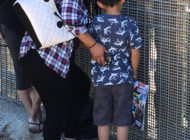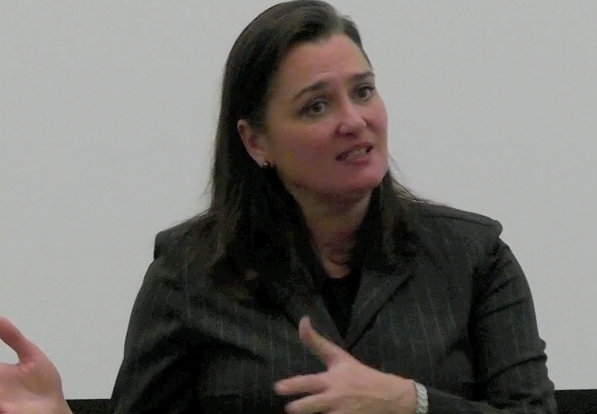By KRISTA DALY
EL NUEVO SOL
The San Fernando Valley (SFV) came into existence when the former governor of California Leland Stanford made a deal with Senator Charles Maclay. Stanford said he would put a railroad across the San Fernando Valley if Maclay would build a town there and by 1874, people started to come.

Midge Gisel, former president of the Historical Society of the SFV, said the progression of the valley happened in five steps.
“First it was the buffalo to help the Indians, then it was the Spanish that brought in the sheep, the Mexicans that brought in the long horn steers, the Europeans brought in the wheat and now we have condominiums,” Gisel said.
Originally the SFV was inhabited by Native Americans, Tongva and Chuman specifically, according to “The Changing Face of the San Fernando Valley” by Joel Kotkin and Erika Ozuna.
By 1800, Spanish settlers overtook the land and the Native American population had been reduced ninety-five percent because of diseases, killings by soldiers, rape and intermarriage.

Gisel said the SFV has always had a largely Hispanic or Mexican population.
“The word Hispanic was never used though, truthfully it was Latin or Mexican or Spanish, but the word Hispanic was not used,” Gisel added. “I’m half Portuguese and if you look in the dictionary that’s actually considered Hispanic too and there were a lot of Portuguese people living in California. They migrated a lot in the early days here.”
Gisel said the ownership of the valley was really between the families of Lankershim and Van Nuys, who were pioneers of the San Fernando Valley.
Isaac Lankershim and Isaac Van Nuys purchased the southern half of the San Fernando Valley and planted wheat, Gisel said.
They were very successful at growing the crop and they earned the name of “The Wheat Kings of the World” because they shipped all over the United States, she added. This was the beginning of the agriculture of the valley.
“Before we had flood control, the valley flooded terribly, just terribly,” Gisel said. “As a native Californian in this area, I would say flood control is really what caused the valley to grow because until they had control of that it was mostly agriculture.”
The Hispanic population that had occupied the SFV was dominated by new European settlers in the 1900s, stated “The Changing Face of the San Fernando Valley.”
According to the 1920 census, just over 21,000 people were in the valley. The city of San Fernando had the highest population at 3,204 people. Burbank had the second highest population at 2, 913 people.
The valley was the fastest growing urban area in the nation, with over 400,000 people by the late 1940s, according to “The Changing Face of the San Fernando Valley.”
“By 1950, Anglos counted for at least ninety percent of the total population,” said Kotkin and Ozuna.
Eugene Turner, geography professor, said chain migration is what caused people to move to another state or area.
“You go to where you have friends or family,” Turner said.
Gisel said her grandparents came to the SFV when their old neighbors, the Warner brothers, wrote them a letter and asked them to move to the valley with them.
Turner added that most of the growth of Latinos in the valley is from births and foreign domestication.
The SFV Economic Research Center at CSUN shows the huge shift in racial demographics from 1980-2004.
According to the SFV Economic Research Center, the white population started with about 940,000 in 1980 and went down to about 780,000 in 2004. The Hispanic population, however, started from about 230,000 and grew to about 770,000 in 2004.
“In the last decade, Hispanics have just passed whites as the most predominant group,” Turner said.
The census states that Hispanics now make up 42% of the population in the SFV, while whites are currently at 41% of the SFV population.
The diversity of the specific cities in the San Fernando Valley varies greatly according to the LA Times Mapping L.A.
Mapping L.A. shows that the most diverse neighborhood is Winnetka, and the least diverse neighborhood is San Fernando, where 89.5% of the population is Latino.
Turner said some of the movement has to do with urban development and other things like that.
“We did a paper on ethnic diversity and the area around Cerritos was the most ethnically diverse in the United States back in the 1980 census,” Turner said. “It’s sort of on the fringe between the suburbs and the central parts of the city. The areas that are low diversity would be east LA, which is all Mexican or Hispanic. The Santa Monica Mountains is all white and southern Orange County is mostly all white.
Gisel said there always was a large Asian population in the valley until World War II.
“I see more of an Asian population coming back all the time in the area,” Gisel said. “The city of San Fernando has changed more. The workers there were actually Latin but they had a largely European population, like people from Sweden and other areas.”
Gisel also said she noticed that the Latin population has gone from agriculture into business. She added that more people are coming in from Iran and different Eastern countries now that didn’t happen years ago.
Timeline of the population of the San Fernando Valley over the years: San Fernando Valley on Dipity.
San Fernando Valley Demographics
Tags: census diversity Hispanic Mexican population San Fernando Valley



















